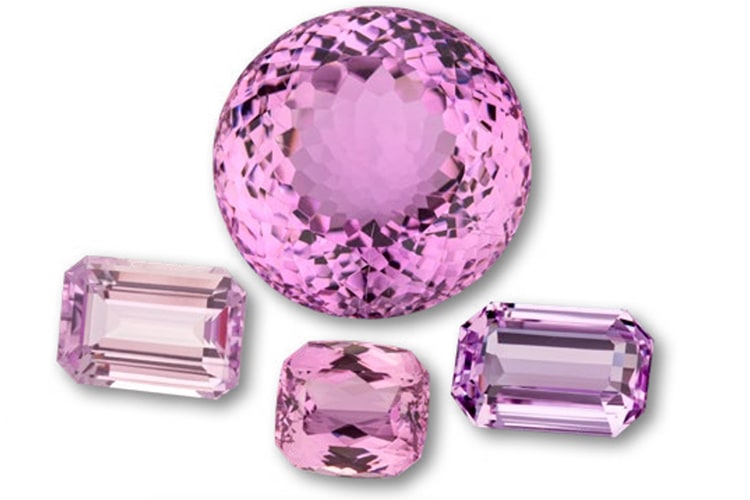Guide to Kunzite

History, Lore and Appreciation
Delicacy and subtlety of color are this gem’s most notable attributes, making it an excellent choice for evening-wear, where its understated pink to lilac color flashes can be divined and admired even at a distance. Rarity also lends this gem an added sense of exclusivity. It is not widespread enough to be known by all gem aficionados, but those who have developed a passion for it are quick to extol its virtues. Kunzite, while rare, may still be found as large crystals that are excellent candidates for jewelry designs that feature large and impressive centre stones.
This gemstone was first discovered near Pala, in California’s San Diego County, in 1902. Crystals were sent for identification to America’s top gem expert, George Frederick Kunz, a notable jeweler, author and gemologist based at Tiffany & Co. at the time. In a report about the new gem, Kunz wrote: “As this is an entirely new gem of a peculiar beauty, a name will be given to it as soon as its characteristics are definitely determined.” As it happened, the gem variety was soon named after him. It was also determined that the gem was a variety of the mineral spodumene, a source for lithium which was often used for industrial purposes. Certainly spodumene, as it had been found till then, hardly qualified for use
as a gemstone. But the delicate pinks, lilacs, and deep purples, were greatly appreciated for those hues, definitely classifying kunzite as a gem. Kunzite has since been found in several other localities around the world. A very rare green spodumene comprises a different variety of the species. It is a chromium- bearing variety, called hiddenite, named after its locality in Hidden, North Carolina, USA. Brazil, and India produce some of this green material also.
Birthstones and Anniversaries
Kunzite is not used as birthstone, though Kunz at one time suggested kunzite as an alternate American birthstone for the month of September, in his book The Curious Lore of Precious Stones (1913).
Description and Properties
Kunzite is a variety of the mineral spodumene that forms in the monoclinic crystal system.
Chemical composition: LiAlSi2O6
Color(s): Light in tone, pink to bluish purple.
Refractive Index: 1.660 to 1.676 (±0.005)
Birefringence: 0.014 to 0.016 Specific Gravity: 3.18 (±0.03) Cause(s) of color: Manganese. Mohs Hardness: 6.5 to 7
Internal identifying characteristics: Kunzite rarely has inclusions, but being of pegmatitic origin, sometimes has a few fluid inclusions. However, kunzite has perfect cleavage, meaning it has a tendency to break or split in certain directions due to its crystal structure.
Treatments
Irradiation may produce pink or deeper pink colors from colorless to pink varieties of spodumene. Kunzite’s color, including irradiated color, is susceptible to fading upon prolonged exposure to light.
Collector Quality
Because kunzite is often thought of as a uniquely American gemstone (though they are also mined elsewhere), gems from the Pala district possess a unique provenance, especially since they were named after a famous American. Depth of color, especially in rich magenta colored gems, is appreciated.
Localities
The United States (the classic source), Afghanistan, Myanmar (Burma), Brazil and Madagascar.
Cutting, Care and Cleaning
Kunzite is often fashioned into large, step cut gems and rarely carved because of its directional cleavage. Care must be taken, especially with gems set in rings, because they tend to absorb the most physical impact. Kunzite should not be cleaned in an ultrasonic cleaner. It is best to use a damp, non-abrasive cloth to clean them. Because of its susceptibility to fade upon prolonged exposure to bright light, kunzite should be kept in a dark storage container when not in use.
Source: CIBJO